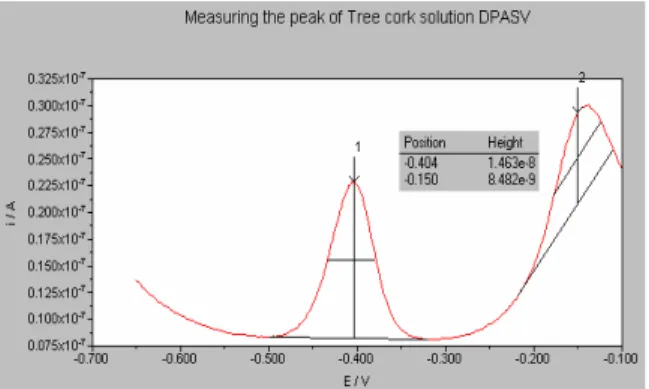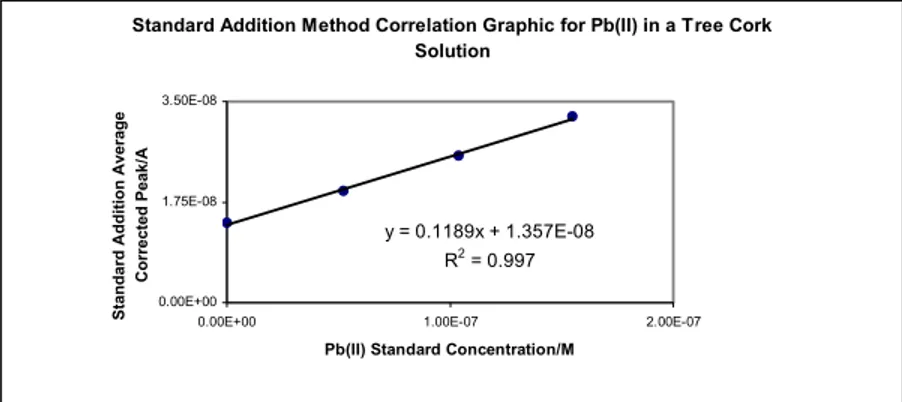Electroanalysis of Heavy Metals in the Cork of Quercus Suber
Tree. Preliminary Study: Electroanaliticity of Pb(II)
J.C.A.C. Ponte e Sousaa)*, J.M. Ginja Teixeiraa), A.M. Neto Vaza),b) a) Departamento de Química, Universidade de Évora. R. Romão Ramalho, 59, 7000-671 Évora.
b) CECUL Fundação da Faculdade de Ciências da Universidade de Lisboa. Edifício C8,
R. Ernesto de Vasconcelos, 1749-016 Lisboa
Received 15 November 2002; accepted in revised form 09 January 2003
Abstract
This will enable Pb(II) determination optimisation, regarding environmental aspects of the perpetuation of Quercus suber Montado (similar to Forest). It will also allow a more profound toxicological quality control of corks (barks). These two last referred aspects are very related ones, once accepted that the more advanced could the certification of the quality patterns of corks (barks) be, more will be the sustainability of Quercus suber ecosystem. Which we believe can be done, amongst other vectors, by studying such an important environmental issue as heavy metals. It is shown that Pb(II) quantification in the cork (bark) of Quercus suber tree (Cork Oak) is possible, using Differential Pulse Anodic Stripping Voltammetry (DPASV). The samples digestion was made in a mixture of H2O2 and HNO3 1:8, in a closed recipient at approximately 90 ºC. The
measures were made in NaCl 0.1 M, using a Hanging Mercury Drop Electrode, a Glassy-Carbon Rod Counter Electrode, and an Ag/AgCl/KCl 3M reference electrode, after a 180 s deposition step. The results have shown the determination of a coherent stripping potential of -0.405 V (SD=0.0005 V), and a fine linear adjustment after the standard addition method (R2 = 0.997). They have also revealed the interest of further studies. The need to test other electroanalysis requisites was understood, and imposed by the proof of the complex nature of the matrix.
Keywords: cork (bark), Quercus suber tree (cork oak), Pb(II), Differential Pulse Anodic
Stripping Voltammetry (DPASV), environment.
Introduction
Portugal holds all maxima regarding production, transformation and disponibilisation of cork (bark) and by products, being Quercus suber (cork oak) montado (similar to forest) an amazing wealth source. Given the natural and extensive origin of its production it occupies considerable areas in Portugal, namely in Alentejo (South (particularly South-West) hot and dry Portugal, placed North to Algarve and South to Lisbon). Its main utilisation is as cork, sealing wine bottles. The mineral characterisation of cork (bark), regarding heavy metals, is important at the cork oak level, and at the vegetal community level, likewise at the cork level, assuming, respectively, ecotoxicological and human toxicological importance. The first, making possible to test the hypothesis of correlation between the environmental disponibility of heavy metals and cork oak forest decline. The second, regarding migration of such metals from the sealing cork to the wine [1].
The amount of work about developing analytical techniques for the quantification of cork heavy metals is extremely low [2], being known some results [3,4], which had led to the validation of a method and to laboratorial certification [5]. The present work shows that it is possible to use electroanalytical techniques, namely Differential Pulse Stripping Voltammetry with a Hanging Mercury Drop Electrode.
Experimental
Reagents and Solutions
Were prepared: A supporting electrolyte solution NaCl 0.1 mol.dm-3 dissolving NaCl (Merck p. a.) in Milli-Q water. A HNO3 0.1 mol.dm-3 solution, done by
dissolving HNO3 65% (Merck p.a.) in Milli-Q water. A Pb(II) 1.1x10-2 mol.dm-3
stock solution, dissolving Pb(NO3)2 (Riedel) in HNO3 0.01 mol.dm-3. A standard
solution Pb(II) 1.1x10-5 mol.dm-3, done diluting the former. Were used as digestor reagents: HNO3 65% (Merck p. a.) and H2O2 30% p/v (Panreac p. a.).
Instrumentation
Differential Pulse Stripping Voltammetry was made using a potentiostat/galvanostat AUTOLAB/PGSTAT 20 (Eco Chemie) associated to a VA Stand 663 (Metrohm). In this equipment were used: a Hanging Mercury Drop Electrode (HMDE), a Glassy-Carbon Rod Counter Electrode, and an Ag/AgCl/KCl 3M reference electrode. Software: GPES 4.9 (Eco Chemie).
Voltammetric conditions
Pretreatment: Purge time: 5 s. Deposition potential: -0.650 V. Deposition potential time: 180 s. Stirrer off during deposition: No. equilibration time: 30 s. Measurement: Cell off after measurement: Yes. Modulation time: 0.05 s. Interval time: 0.25 s. Potentials: Initial potential: -0.650 V. Final potential: -0.1 V. Step potential: 0.00195 V. Modulation amplitude: 0.03 V. Scanning velocity: 7.8 mV/s.
Other characteristics:
Drop Surface: 0.25 mm2 ± 10%. Agitator rotation velocity: 1500 min-1.
Deaeration time: 10-12 min.
Procedure
Digestion: Several tree cork (with no industrial treatment) digestions were made, according to the following scheme: extraction of cork oak bark faces; granulation with a plastic granulator; weighing 0.1 g of bark powder from granulation; addition of 2 mL HNO3 and 0.25 mL of H2O2; waiting for 2 hours,
approximately; digestion in closed recipient (85-90 ºC) for 8 hours.
Voltammetries: Quantities of 0.1 mL of standard were added to 1 mL of cork solution and 20 mL supporting electrolyte. Each measurement was made three times in each addition.
Experimental Results
Table 1. E and i were measured three times for supporting electrolyte and for
each addition. Standard additions were of 0.1 mL 1.1e-5M Pb(II) to 21 mL (20 mL NaCl 0.1M and 1 mL cork solution). E- Peak Potential (Versus Ag/AgCl/KCl 3mol.dm-3. In NaCl 0.1 mol.dm-3); i- Peak Current Intensity; SD- Standard Deviation; Med- Average Value; Cp- Standard Concentration; icr = i ( (Ves+Va+ΣVp) / (Ves+Va) )- Corrected Peak Intensity Current; Ves- Supporting Electrolyte Volume; Va- Sample Volume; Vp- Standard Addition Volume.
E med/V ± 103 SD/V 109 i med/A ± 1010 i SD/A 109 icr med/A ± 1010 icr SD/A 10 8 Cp/M Supporting Electrolyte -0,380 ± 0 9,094 ± 1,065 9,094 ± 1,065 0 Cork Solution -0,405 ± 1 13,95 ± 6,029 13,95 ± 6,029 0 1st Standard Addition -0,405 ± 1 19,39 ± 1,484 19,49 ± 1,491 5,213 2nd Standard Addition -0,405 ± 1 25,53 ± 4,148 25,77 ± 4,187 10,38 3rd Standard Addition -0,404 ± 0 32,37 ± 4,285 32,83 ± 4,346 15,49
Figure 1. Tree cork solution DPASV- The first of three replicas made with the
granulated tree cork solution.
Figure 2. Measuring the peak of the first replica made with the granulated tree
Figure 3. The peaks evolve in the following order, bottom-up: Supporting
electrolyte, cork digestion solution, 1st, 2nd and 3rd standard additions. Three
replicas were made for each addition.
Figure 4. Correlation analysis by the Minimum Square Method using data
according to Table 1.
Final Comments
Having been achieved the objective of testing the Pb(II) possibility of electroanalysis in such a natural and complex media like non industrially treated cork, it can be concluded the following:
We have found a Pb(II) Redissolution Potential, originated in a cork solution, equal to -0.405 V (SD=0.0005 V), with a HMDE versus Ag/AgCl/KCl 3 mol dm-3 in NaCl 0.1 mol dm-3. This is a very acceptable result, knowing that [6] shows for Pb(II) reduction an E1/2 Versus SCE, in 0.1 F KCl, of –0.4 mV; and [7]
shows for Pb(II) DPASV in 0.5 M NaCl a potential of approximately –0.4 mV, HMDE versus SCE.
It was obtained a satisfactory linear correlation coefficient with the standard addition method. R2=0.997 when icr med is putt against Cp.
Standard Addition Method Correlation Graphic for Pb(II) in a Tree Cork Solution y = 0.1189x + 1.357E-08 R2 = 0.997 0.00E+00 1.75E-08 3.50E-08
0.00E+00 1.00E-07 2.00E-07
Pb(II) Standard Concentration/M
Standard Addition Average
to Cu(II).
It was shown the capacity of DPASV to qualitatively analyse Pb(II) in a cork solution like that shown here, leading the way to quantitative determination. These studies will continue. More samples will be analysed, with more repetitions of the measurements and with more essays. Tests will be done to other digestor solutions, other supporting electrolytes, other deposition potentials and times, other recipient materials, namely regarding the influence they may have in the final quantification.
Acknowledgements
We thank, very particularly, the initial support given by Eng.a Maria Elisa Soares (Laboratório de Toxicologia da Faculdade de Farmácia da Universidade do Porto).
References
1. M.E. Soares, M.A. Borges, M.L. Bastos, M.A. Ferreira, Ciência Téc. Vitiv. 11 (1994) 87-99.
2. L. Gil, Cortiça, Produção, Tecnologia e Aplicação, INETI, Lisboa. 1998. p. 254.
3. M.E. Soares, M.L. Bastos, M.A. Ferreira, J. Anal. At. Spectrom. 8 (1993) 655-657.
4. M.A. Ferreira, M.E. Soares, M.L. Bastos, J.M. Leal Ferreira, CTCOR Magazine 1 (1996) 48-57.
5. http://corkqc.com/ctcorprc.htm
6. D.T. Sawyer, J.L. Roberts, Electrochemistry for Chemists, John Wiley and Sons. 1974. p. 369.
7. A.M. Bond, Modern Polarographic Methods in Analytical Chemistry, Marcel Dekker Inc. 1980. pp. 456-457.

